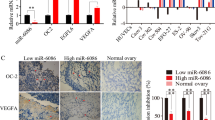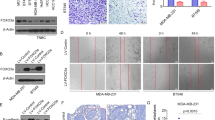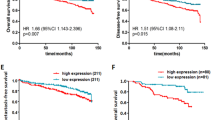Abstract
MicroRNA-155 (miR-155) is frequently upregulated in various types of human cancer; however, its role in cancer angiogenesis remains unknown. Here, we demonstrate the role of miR-155 in angiogenesis through targeting von Hippel-Lindau (VHL) tumour suppressor in breast cancer. Ectopic expression of miR-155 induced whereas knockdown of miR-155 inhibited human umbilical vein endothelial cell network formation, proliferation, invasion and migration. Furthermore, mammary fat pad xenotransplantation of ectopically expressed miR-155 resulted in extensive angiogenesis, proliferation, tumour necrosis and recruitment of pro-inflammatory cells such as tumour-associated macrophages. Expression of VHL abrogated these miR-155 effects. Moreover, miR-155 expression inversely correlates with VHL expression level and is associated with late-stage, lymph node metastasis and poor prognosis, as well as triple-negative tumour in breast cancer. These findings indicate that miR-155 has a pivotal role in tumour angiogenesis by downregulation of VHL, and provide a basis for miR-155-expressing tumours to embody an aggressive malignant phenotype, and therefore miR-155 is an important therapeutic target in breast cancer.
This is a preview of subscription content, access via your institution
Access options
Subscribe to this journal
Receive 50 print issues and online access
$259.00 per year
only $5.18 per issue
Buy this article
- Purchase on Springer Link
- Instant access to full article PDF
Prices may be subject to local taxes which are calculated during checkout








Similar content being viewed by others
References
Baeriswyl V, Christofori G . The angiogenic switch in carcinogenesis. Semin Cancer Biol 2009; 19: 329–337.
Bergers G, Benjamin LE . Tumourigenesis and the angiogenic switch. Nat Rev Cancer 2003; 3: 401–410.
Bouck N, Stellmach V, Hsu SC . How tumours become angiogenic. Adv Cancer Res 1996; 69: 135–174.
Folkman J, Watson K, Ingber D, Hanahan D . Induction of angiogenesis during the transition from hyperplasia to neoplasia. Nature 1989; 339: 58–61.
Folkman J . Role of angiogenesis in tumour growth and metastasis. Semin Oncol 2002; 29: 15–18.
Hanahan D, Folkman J . Patterns and emerging mechanisms of the angiogenic switch during tumourigenesis. Cell 1996; 86: 353–364.
Allavena P, Sica A, Solinas G, Porta C, Mantovani A . The inflammatory micro-environment in tumour progression: the role of tumour-associated macrophages. Crit Rev Oncol Hematol 2008; 66: 1–9.
Balkwill F . Cancer and the chemokine network. Nat Rev Cancer 2004; 4: 540–550.
Solinas G, Germano G, Mantovani A, Allavena P . Tumour-associated macrophages (TAM) as major players of the cancer-related inflammation. J Leukoc Biol 2009; 86: 1065–1073.
Folkman J . Angiogenesis in cancer, vascular, rheumatoid and other disease. Nat Med 1995; 1: 27–31.
Risau W . Mechanisms of angiogenesis. Nature 1997; 386: 671–674.
Bartel DP . MicroRNAs: target recognition and regulatory functions. Cell 2009; 136: 215–233.
Cha ST, Chen PS, Johansson G, Chu CY, Wang MY, Jeng YM et al. MicroRNA-519c suppresses hypoxia-inducible factor-1alpha expression and tumour angiogenesis. Cancer Res 2010; 70: 2675–2685.
Yamakuchi M, Lotterman CD, Bao C, Hruban RH, Karim B, Mendell JT et al. P53-induced microRNA-107 inhibits HIF-1 and tumour angiogenesis. Proc Natl Acad Sci USA 2010; 107: 6334–6339.
Fang L, Deng Z, Shatseva T, Yang J, Peng C, Du WW et al. MicroRNA miR-93 promotes tumour growth and angiogenesis by targeting integrin-beta8. Oncogene 2011; 30: 806–821.
Eis PS, Tam W, Sun L, Chadburn A, Li Z, Gomez MF et al. Accumulation of miR-155 and BIC RNA in human B cell lymphomas. Proc Natl Acad Sci USA 2005; 102: 3627–3632.
Iorio MV, Ferracin M, Liu CG, Veronese A, Spizzo R, Sabbioni S et al. MicroRNA gene expression deregulation in human breast cancer. Cancer Res 2005; 65: 7065–7070.
Kluiver J, Poppema S, de Jong D, Blokzijl T, Harms G, Jacobs S et al. BIC and miR-155 are highly expressed in Hodgkin, primary mediastinal and diffuse large B cell lymphomas. J Pathol 2005; 207: 243–249.
Volinia S, Calin GA, Liu CG, Ambs S, Cimmino A, Petrocca F et al. A microRNA expression signature of human solid tumours defines cancer gene targets. Proc Natl Acad Sci USA 2006; 103: 2257–2261.
Yanaihara N, Caplen N, Bowman E, Seike M, Kumamoto K, Yi M et al. Unique microRNA molecular profiles in lung cancer diagnosis and prognosis. Cancer Cell 2006; 9: 189–198.
Jiang S, Zhang HW, Lu MH, He XH, Li Y, Gu H et al. MicroRNA-155 functions as an OncomiR in breast cancer by targeting the suppressor of cytokine signaling 1 gene. Cancer Res 2010; 70: 3119–3127.
Kong W, Yang H, He L, Zhao JJ, Coppola D, Dalton WS et al. MicroRNA-155 is regulated by the transforming growth factor beta/Smad pathway and contributes to epithelial cell plasticity by targeting RhoA. Mol Cell Biol 2008; 28: 6773–6784.
Kong W, He L, Coppola M, Guo J, Esposito NN, Coppola D et al. MicroRNA-155 regulates cell survival, growth, and chemosensitivity by targeting FOXO3a in breast cancer. J Biol Chem 2010; 285: 17869–17879.
O’Connell RM, Taganov KD, Boldin MP, Cheng G, Baltimore D . MicroRNA-155 is induced during the macrophage inflammatory response. Proc Natl Acad Sci USA 2007; 104: 1604–1609.
Pedersen IM, Otero D, Kao E, Miletic AV, Hother C, Ralfkiaer E et al. Onco-miR-155 targets SHIP1 to promote TNFalpha-dependent growth of B cell lymphomas. EMBO Mol Med 2009; 1: 288–295.
Thai TH, Calado DP, Casola S, Ansel KM, Xiao C, Xue Y et al. Regulation of the germinal center response by microRNA-155. Science 2007; 316: 604–608.
Tili E, Michaille JJ, Cimino A, Costinean S, Dumitru CD, Adair B et al. Modulation of miR-155 and miR-125b levels following lipopolysaccharide/TNF-alpha stimulation and their possible roles in regulating the response to endotoxin shock. J Immunol 2007; 179: 5082–5089.
Tili E, Michaille JJ, Wernicke D, Alder H, Costinean S, Volinia S et al. Mutator activity induced by microRNA-155 (miR-155) links inflammation and cancer. Proc Natl Acad Sci USA 2011; 108: 4908–4913.
Vigorito E, Perks KL, Abreu-Goodger C, Bunting S, Xiang Z, Kohlhaas S et al. microRNA-155 regulates the generation of immunoglobulin class-switched plasma cells. Immunity 2007; 27: 847–859.
Babar IA, Czochor J, Steinmetz A, Weidhaas JB, Glazer PM, Slack FJ . Inhibition of hypoxia-induced miR-155 radiosensitizes hypoxic lung cancer cells. Cancer Biol Ther 2011; 12: 908–914.
Suarez Y, Fernandez-Hernando C, Yu J, Gerber SA, Harrison KD, Pober JS et al. Dicer-dependent endothelial microRNAs are necessary for postnatal angiogenesis. Proc Natl Acad Sci USA 2008; 105: 14082–14087.
Coultas L, Chawengsaksophak K, Rossant J . Endothelial cells and VEGF in vascular development. Nature 2005; 438: 937–945.
Jain RK . Molecular regulation of vessel maturation. Nat Med 2003; 9: 685–693.
Kaelin WG . The von Hippel-Lindau tumour suppressor protein: O2 sensing and cancer. Nat Rev Cancer 2008; 8: 865–873.
Andorfer CA, Necela BM, Thompson EA, Perez EA . MicroRNA signatures: clinical biomarkers for the diagnosis and treatment of breast cancer. Trends Mol Med 2011; 17: 313–319.
Suárez Y, Sessa WC . MicroRNAs as novel regulators of angiogenesis. Circ Res 2009; 104: 442–454.
Kim WY, Kaelin WG . Role of VHL gene mutation in human cancer. J Clin Oncol 2004; 22: 4991–5004.
Zia MK, Rmali KA, Watkins G, Mansel RE, Jiang WG . The expression of the von Hippel-Lindau gene product and its impact on invasiveness of human breast cancer cells. Int J Mol Med 2007; 20: 605–611.
Greer SN, Metcalf JL, Wang Y, Ohh M . The updated biology of hypoxia-inducible factor. EMBO J 2012; 3: 2448–2460.
Krishnamachary B, Penet MF, Nimmagadda S, Mironchik Y, Raman V, Solaiyappan M et al. Hypoxia regulates CD44 and its variant isoforms through HIF-1α in triple negative breast cancer. PLoS One 2012; 7: e44078.
Montagner M, Enzo E, Forcato M, Zanconato F, Parenti A, Rampazzo E et al. SHARP1 suppresses breast cancer metastasis by promoting degradation of hypoxia-inducible factors. Nature 2012; 487: 380–384.
Li M, Kim WY . Two sides to every story: the HIF-dependent and HIF-independent functions of pVHL. J Cell Mol Med 2011; 15: 187–195.
Albini A, Tosetti F, Benelli R, Noonan DM . Tumour inflammatory angiogenesis and its chemoprevention. Cancer Res 2005; 65: 10637–10641.
Bergers G, Hanahan D, Coussens LM . Angiogenesis and apoptosis are cellular parameters of neoplastic progression in transgenic mouse models of tumourigenesis. Int J Dev Biol 1998; 42: 995–1002.
Skobe M, Rockwell P, Goldstein N, Vosseler S, Fusenig NE . Halting angiogenesis suppresses carcinoma cell invasion. Nat Med 1997; 3: 1222–1227.
Coussens LM, Werb Z . Inflammation and cancer. Nature 2002; 420: 860–867.
Luo JL, Maeda S, Hsu LC, Yagita H, Karin M . Inhibition of NF-kappaB in cancer cells converts inflammation- induced tumour growth mediated by TNFalpha to TRAIL-mediated tumour regression. Cancer Cell 2004; 6: 297–305.
Ono M . Molecular links between tumour angiogenesis and inflammation: inflammatory stimuli of macrophages and cancer cells as targets for therapeutic strategy. Cancer Sci 2008; 99: 1501–1506.
Chang S, Wang RH, Akagi K, Kim KA, Martin BK, Cavallone L et al. Tumour suppressor BRCA1 epigenetically controls oncogenic microRNA-155. Nat Med 2011; 17: 1275–1282.
Foulkes WD, Stefansson IM, Chappuis PO, Begin LR, Goffin JR, Wong N et al. Germline BRCA1 mutations and a basal epithelial phenotype in breast cancer. J Natl Cancer Inst 2003; 95: 1482–1485.
Lakhani SR, Reis-Filho JS, Fulford L, Penault-Llorca F, van der Vijver M, Parry S et al. Prediction of BRCA1 status in patients with breast cancer using estrogen receptor and basal phenotype. Clin Cancer Res 2005; 11: 5175–5180.
Karginov FV, Conaco C, Xuan Z, Schmidt BH, Parker JS, Mandel G et al. A biochemical approach to identifying microRNA targets. Proc Natl Acad Sci USA 2007; 104: 19291–19296.
Keene JD, Komisarow JM, Friedersdorf MB . RIP-Chip: the isolation and identification of mRNAs, microRNAs and protein components of ribonucleoprotein complexes from cell extracts. Nat Protoc 2006; 1: 302–307.
Acknowledgements
This work was supported by grants from the National Institute of Health (CA114343 to TAS, CA115308 to JYD, and CA137041 to JQC) and Florida Bankhead-Coley Cancer Research Program (2BB01 to JQC).
Author information
Authors and Affiliations
Corresponding author
Ethics declarations
Competing interests
The authors declare no conflict of interest.
Additional information
Supplementary Information accompanies the paper on the Oncogene website
Supplementary information
Rights and permissions
About this article
Cite this article
Kong, W., He, L., Richards, E. et al. Upregulation of miRNA-155 promotes tumour angiogenesis by targeting VHL and is associated with poor prognosis and triple-negative breast cancer. Oncogene 33, 679–689 (2014). https://doi.org/10.1038/onc.2012.636
Received:
Revised:
Accepted:
Published:
Issue Date:
DOI: https://doi.org/10.1038/onc.2012.636
Keywords
This article is cited by
-
The various role of microRNAs in breast cancer angiogenesis, with a special focus on novel miRNA-based delivery strategies
Cancer Cell International (2023)
-
Impact of three miRNA signature as potential diagnostic marker for triple negative breast cancer patients
Scientific Reports (2023)
-
Non-coding RNA’s prevalence as biomarkers for prognostic, diagnostic, and clinical utility in breast cancer
Functional & Integrative Genomics (2023)
-
The Diagnostic and Prognostic Value of miR-155 in Cancers: An Updated Meta-analysis
Molecular Diagnosis & Therapy (2023)
-
Programming inactive RNA-binding small molecules into bioactive degraders
Nature (2023)



